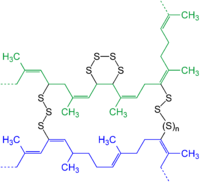
Photo from wikipedia
The development of MS-cleavable cross-linking mass spectrometry (XL-MS) has enabled the effective capture and identification of endogenous protein-protein interactions (PPIs) and their residue contacts at the global scale without cell… Click to show full abstract
The development of MS-cleavable cross-linking mass spectrometry (XL-MS) has enabled the effective capture and identification of endogenous protein-protein interactions (PPIs) and their residue contacts at the global scale without cell engineering. So far, only lysine-reactive cross-linkers have been successfully applied for proteome-wide PPI profiling. However, lysine cross-linkers alone cannot uncover the complete PPI map in cells. Previously, we have developed a maleimide-based cysteine-reactive MS-cleavable cross-linker (bismaleimide sulfoxide (BMSO)) that is effective for mapping PPIs of protein complexes to yield interaction contacts complementary to lysine-reactive reagents. While successful, the hydrolysis and limited selectivity of maleimides at physiological pH make their applications in proteome-wide XL-MS challenging. To enable global PPI mapping, we have explored an alternative cysteine-labeling chemistry and thus designed and synthesized a sulfoxide-containing MS-cleavable haloacetamide-based cross-linker, Dibromoacetamide sulfoxide (DBrASO). Our results have demonstrated that DBrASO cross-linked peptides display the same fragmentation characteristics as other sulfoxide-containing MS-cleavable cross-linkers, permitting their unambiguous identification by MSn. In combination with a newly developed two-dimensional peptide fractionation method, we have successfully performed DBrASO-based XL-MS analysis of HEK293 cell lysates and demonstrated its capability to complement lysine-reactive reagents and expand PPI coverage at the systems-level.
Journal Title: Analytical chemistry
Year Published: 2023
Link to full text (if available)
Share on Social Media: Sign Up to like & get
recommendations!